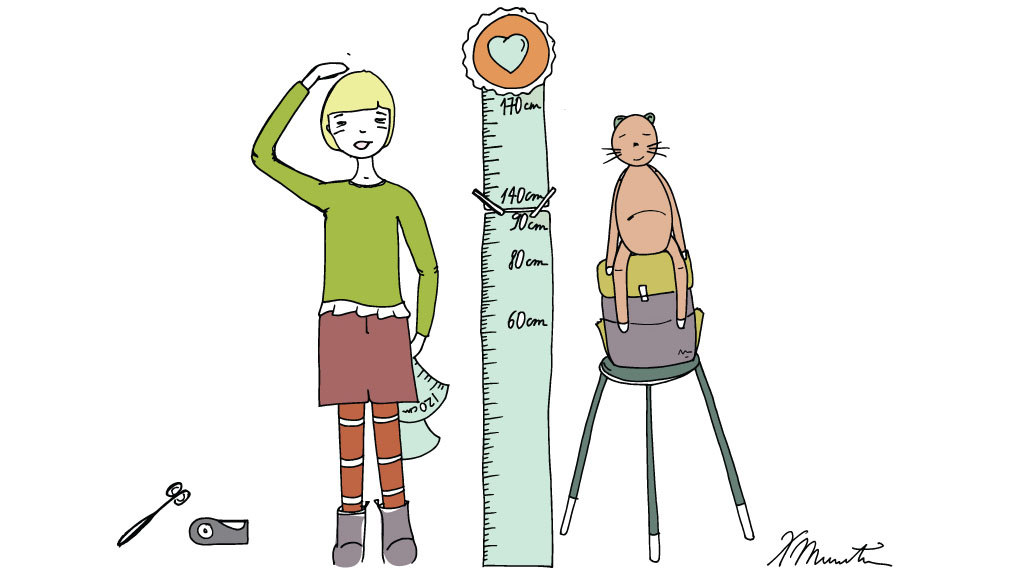Growth Charts For Children: A Weighty Tradition

Birth announcements are a very popular tradition and usually show the name and gender of the newborn, as well as the exact time of delivery. It is also essential to include birth weight: if you don’t mention it, people are bound to ask! Weight is one of those things that people just can’t help commenting on. We have all heard phrases like: “What a big baby!” “My babies get heavier with each pregnancy.” “The women in our family always have small babies,” etc. Both height and weight are used so frequently when comparing siblings that children can end up defining their family position using these characteristics. Some of us have probably grown up always being the “chubby one,” the “tall one,” or the “skinny one” in the family.
Using growth charts
Measuring children is something that has been done for years. Obviously children grow at different rates at different ages, and there are lots of differences between individuals. So although it is difficult to define “normal” growth, we can still get a good idea of how a particular child is growing by comparing their measurements with other children of the same age and gender.
Earlier, growth charts were used mainly to identify underweight children. These days, charts are more frequently used to look out for children becoming obese. When you take your child to see his or her paediatrician, usually the child’s height and weight (and head size in babies) are checked and plotted on a chart. Weighing and measuring helps show that your child is growing as expected.
Growth charts help identify things like weight loss or not gaining weight, which can be early signs of a medical condition like a heart defect or an inherited condition, or even child abuse or neglect.
International growth charts
Is it possible to have a chart that can measure and compare the height and weight of any child in any country in the world? This task was tackled by the World Health Organisation (WHO), which created the updated growth charts (the WHO Child Growth Standards) that have been used by multiple countries over the last eight years.
The WHO based their chart on children in Brazil, Ghana, India, Norway, Oman and the United States. These children were brought up in conditions as ideal as possible – well-fed, healthy children, not deprived. The WHO growth charts show “normal” childhood growth, i.e., how your child should grow, regardless of ethnicity, socio-economic conditions, or diet.
The “one-growth-chart-suits-all” approach
Developing a growth chart to use with every single child in the whole world is difficult. Before the updated WHO growth chart, many charts were based on measurements from children in the United States. These old American charts are often considered “inaccurate” when used to monitor breastfed babies, because they seem to suggest that breastfed babies just don’t gain weight well enough.
The updated WHO growth chart takes into account that breastfed babies gain weight faster earlier on, then have slower weight gain for the rest of their first year. A criticism of the WHO growth chart is that it focuses on breastfed babies too much, making other babies seem “obese.”
Most countries have adapted the WHO growth chart, preferring to use local national data as well, rather than the WHO “one-growth-chart-suits-all” approach. Some countries use the WHO growth chart for children aged zero to two, then switch to their own country’s charts for older children.
Paediatricians often have their own preferences. Your paediatrician may be using the growth charts based on data from the Zurich region and printed by Nestlé. The data for these charts were based on healthy Swiss children from the 1950s, with ongoing studies also looking at children two generations further along.
Does it matter which growth chart my paediatrician uses?
Growth charts are a monitoring tool; that is all. They all have limitations. What is important is the ability to interpret results taking into account these limitations. If your child is not gaining weight according to the chart being used, then it may be worth questioning the growth chart as well as considering possible medical or nutritional reasons.
If you are an expat who moves countries frequently, you may wish to compare which growth charts are being used each time you move. In most cases, it probably makes little difference which chart it is, unless your child is on the lower end of the scale for weight or height, or on the extremes of a growth chart, or fluctuating a lot across the chart. Changes in weight or height spanning across a chart are indicators that your child may need monitoring or investigating.
The anxiety that surrounds growth charts
Growth charts are not there to make you feel guilty or make you feel as if you are not feeding your child properly. Growth charts are useful for highlighting issues that may or may not need intervention. They play an important role in the early detection of medical conditions and are helpful when considering a child’s calorie intake. Sensible interpretation of a growth chart includes taking account of the following too: the size of the child’s parents and other family members; gains in weight/height that are consistent; reaching developmental milestones; height variations according to different nationalities and different ethnic groups; and a happy, active child.
There would be less anxiety around growth charts if we looked at the overall health and well-being of the child as well and didn’t focus so heavily on the numbers themselves.
Growth charts and you
What has been your experience of growth charts? Good? Bad?
Many families have a tradition of using a height chart to monitor their kids at home. Do you have a height chart stuck to your wall?
Can you remember the exact birthweight of your child(ren)?
By Dr. Jahura Hossain
Born and brought up in London, Jahura is a U.K.-qualified doctor. She has worked in hospitals, general practice, public health, prison medicine, and the pharmaceutical industry.
Illustration by Laura Munteanu
Laura has studied Journalism and Advertising, and has been working as a journalist and an illustrator. She has been illustrating for magazines, websites, charity and different campaigns. She lives in Zurich with her husband and their six-year-old daughter.
© Copyright. Jahura Hossain. 2014. All rights reserved. No part of this article may be reproduced without the express consent of the author.



